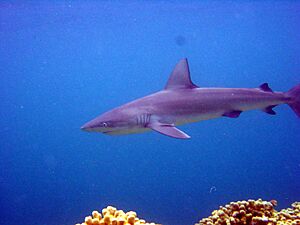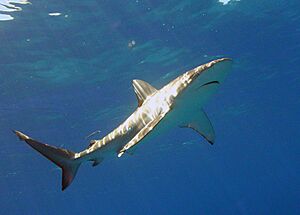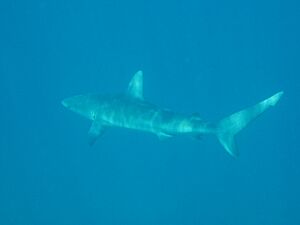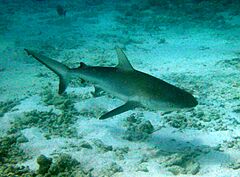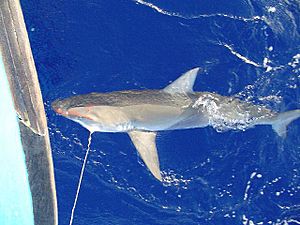Galapagos shark facts for kids
Quick facts for kids Galapagos sharkTemporal range: Pliocene–Recent
|
|
|---|---|
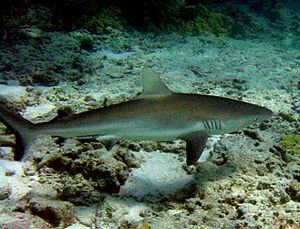 |
|
| Conservation status | |
| Scientific classification | |
| Genus: |
Carcharhinus
|
| Species: |
galapagensis
|
 |
|
| Range of the Galapagos shark | |
| Synonyms | |
|
Carcharias galapagensis Snodgrass & Heller, 1905 |
|
The Galapagos shark (Carcharhinus galapagensis) is a type of shark found all over the world. It belongs to a family called requiem sharks. It loves clear waters around islands with coral reefs. Here, it's often the most common shark.
This is a big shark, growing up to 3 meters (10 feet) long. It has the usual sleek shape of a reef shark. It can be hard to tell apart from the dusky shark (C. obscurus) and the grey reef shark (C. amblyrhynchos). One way to spot it is its tall first fin on its back (dorsal fin). This fin has a slightly rounded tip. It starts right above the back tips of its front fins (pectoral fins).
Galapagos sharks are active hunters and often swim in large groups. They mostly eat fish that live near the bottom and cephalopods like octopuses. Bigger sharks eat many different things. This includes other sharks, marine iguanas, sea lions, and even trash.
Like other requiem sharks, baby Galapagos sharks grow inside their mother. Females give birth to 4 to 16 pups every 2 to 3 years. Young sharks stay in shallow water. This helps them avoid being eaten by bigger sharks. The International Union for Conservation of Nature (IUCN) says this shark is of "least concern." But it reproduces slowly. Also, a lot of fishing happens where it lives.
Contents
About the Galapagos Shark Name
The Galapagos shark was first named Carcharias galapagensis in 1905. This was done by Robert Evans Snodgrass and Edmund Heller. Later, scientists moved it to the Carcharhinus group of sharks. The first shark studied was a 65 cm (2.1 ft) long baby. It came from the Galapagos Islands. This is why its name includes galapagensis.
Where Galapagos Sharks Live
Galapagos sharks mostly live near tropical islands in the ocean.
- In the Atlantic Ocean, you can find them near Bermuda, the Virgin Islands, Madeira, and Cape Verde.
- In the Indian Ocean, they are known from Walter's Shoal near southern Madagascar.
- In the Pacific Ocean, they live around places like the Hawaiian Islands, the Galapagos Islands, and Cocos Island.
Sometimes, they are seen closer to continents. This includes areas off Baja California and eastern Australia.
These sharks usually live over shelves of land under the sea. They like rugged reefs with clear water. They also like places with strong ocean currents. They can swim across the open ocean between islands. They have been seen at least 50 km (31 mi) from land. Young sharks usually stay in water shallower than 25 meters (82 ft). Adult sharks have been found as deep as 180 meters (590 ft).
What Does a Galapagos Shark Look Like?
The Galapagos shark is one of the biggest sharks in its group. It often grows to 3 meters (10 ft) long. Some have been recorded up to 3.7 meters (12 ft). The heaviest recorded was 195 kg (430 lb) for a 3-meter female.
This shark has a slim, smooth body. Its snout is wide and round. Its eyes are round and medium-sized. Its mouth usually has 14 rows of teeth on each side of both jaws. There is also one tooth in the middle. The top teeth are strong and triangle-shaped. The bottom teeth are narrower. Both have jagged edges.
The first dorsal fin (on its back) is tall and curved like a sickle. It starts above the back tips of the pectoral fins. There is a low ridge along its back to the second dorsal fin. The second dorsal fin starts above the anal fin. Its pectoral fins are large with pointed tips.
The shark's color is brownish-gray on top and white underneath. It has a faint white stripe on its sides. The edges of its fins are darker. It can be hard to tell this shark apart from the dusky shark or grey reef shark. However, the Galapagos shark has taller dorsal fins and bigger teeth than the dusky shark. It also has a less strong body and a less pointed first dorsal fin than the grey reef shark.
Life and Habits of the Galapagos Shark
The Galapagos shark is often the most common shark in shallow island waters. Early explorers saw "thousands" of them in the water. At the Saint Peter and Paul Rocks, there are so many Galapagos sharks that it's one of the densest shark groups in the Atlantic Ocean. They sometimes gather in large groups.
When different sharks interact, Galapagos sharks are stronger than blacktip sharks. But they are not as strong as silvertip sharks of the same size. If a Galapagos shark feels trapped, it might do a shark threat display. It will swim in an exaggerated, rolling way. It will arch its back, lower its pectoral fins, puff out its gills, and open its jaw. It might also swing its head to keep the threat in sight. A tiny worm called Dermophthirius carcharhini can live on the shark's skin. Sometimes, a bluefin trevally fish rubs against the shark to get rid of its own parasites.
What Do Galapagos Sharks Eat?
Galapagos sharks mainly eat fish that live on the sea bottom. This includes eels, sea bass, and octopuses. They also sometimes eat prey from the surface, like mackerel and squid. As the sharks get bigger, they eat more rays and smaller sharks. This can even include other Galapagos sharks. They also eat things that are not food, like leaves, coral, rocks, and trash.
At the Galapagos Islands, these sharks have been seen attacking Galapagos fur seals, sea lions, and marine iguanas. Near Clipperton Island, young Galapagos sharks would rush at almost anything in the water. They would hit boats, oars, and buoys. They were not scared away by fish toxins or shark repellents. Some even followed boats into water so shallow their backs were out of the water.
Galapagos Shark Life Cycle
Like other requiem sharks, Galapagos sharks give birth to live young. The babies grow inside the mother, getting food from a special connection. Females have babies every 2 to 3 years. Mating happens from January to March. After mating, females have bite marks from the males.
The babies grow for about one year. The next spring, females go to shallow areas to give birth. They have 4 to 16 pups. The babies are usually 61 to 80 cm (2.0 to 2.6 ft) long when born. Young sharks stay in shallow water to avoid being eaten by bigger adults. Males become adults when they are 2.1 to 2.5 meters (6.9 to 8.2 ft) long and 6 to 8 years old. Females become adults when they are 2.2 to 2.5 meters (7.2 to 8.2 ft) long and 7 to 9 years old. They are not thought to have babies until they are 10 years old. These sharks can live for at least 24 years.
Galapagos Sharks and People
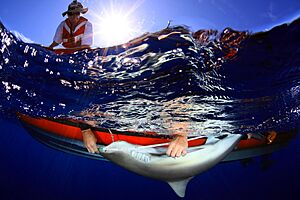
Galapagos sharks are curious and can be persistent. They are seen as possibly dangerous to humans. However, many boats take divers to the Galapagos Islands to swim with these sharks. Only a few incidents have been reported. They are known to swim close to people. They show interest in swim fins or hands. Fishing activities can also attract many of them.
In the past, people saw sharks rushing at caught fish. Even with oars and boat hooks, the sharks would not stop. They would take more than half the fish. One observer noted that young sharks would circle and become more aggressive. They were not easily scared away. The situation got so intense that divers had to leave the water. Excited Galapagos sharks are hard to stop. Trying to push one away might make it circle back and encourage others to follow.
As of 2008, the Galapagos shark has been confirmed to have bitten three people. Two of these incidents were very serious in the Virgin Islands. A third incident in Bermuda was not serious. In 2018, there was another incident in the Galapagos Islands. It might have been a Galapagos shark, but this is not confirmed.
The International Union for Conservation of Nature (IUCN) says the Galapagos shark is of "least concern." But because it has babies slowly, its numbers can drop easily. We don't have exact numbers on how many are caught by fishing boats. But this shark is definitely caught by commercial fishing in many areas. Its meat is said to be very good. While still common in places like Hawaii, the Galapagos shark might have disappeared from some areas. Its scattered locations mean other groups might also be at risk. The sharks at the Kermadec and Galapagos Islands are protected in special marine areas.
Conservation Status
The New Zealand Department of Conservation has said the Galapagos shark is "Not Threatened." This means it is not in danger in New Zealand. They also note it is "Conservation Dependent" and "Secure Overseas."
Images for kids
See also
 In Spanish: Tiburón de Galápagos para niños
In Spanish: Tiburón de Galápagos para niños



